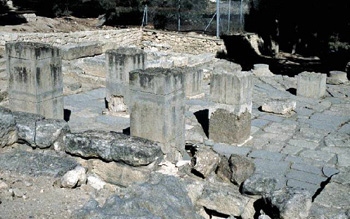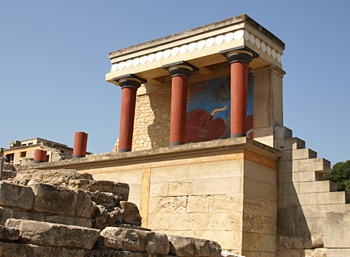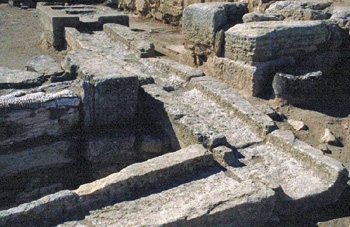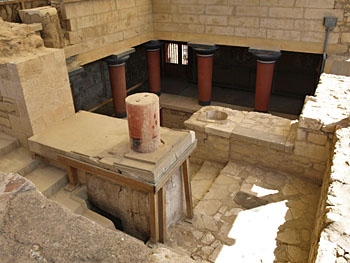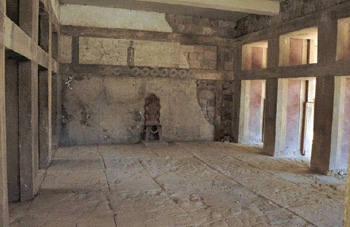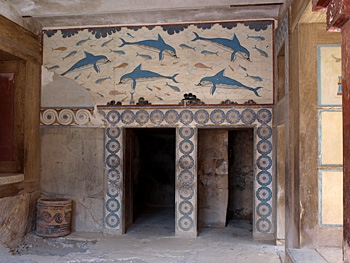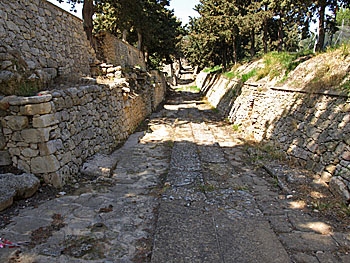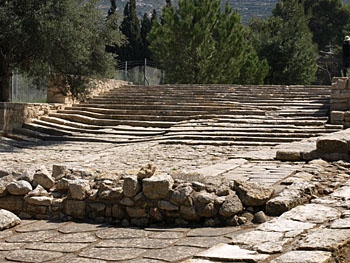The North Entrance
The north entrance to the palace would have been via the North Pillar Hall, which Evans considered to be the main public entrance into the Palace. Given the narrow doorway that leads into the hall, this seems unlikely. More likely it was used by those needing to access the north part of the Palace.
From there one could go, via the North Entrance Passage, to the north end of the Central Court. This passage way was originally open to the elements but some time after 1700 BCE it was covered over.
It is thought that there may have been a dining area above the North Pillar Hall. Inside the Pillar Hall itself a large number of incised clay tablets were found, which suggests that this was an administrative area. Being close to an entrance to the Palace, the area may have been used to record produce as it was brought into the Palace.The North Pillar Hall may also have been a place where people newly arrived at the palace would gather. Parts of the hall have been heavily restored, including some of the pillars and steps.
Immediately south of the North Pillar Hall is the Bull Chamber, which was on the same level as the Central Court. It was here that the Bull Relief Fresco was found. Opposite this chamber there would originally have been another, also decorated with a fresco.
The north east corner of the Palace was found to be badly damaged when it was excavated and this makes it difficult to understand what the area was originally used for. The north east corner contained a large number of store rooms. Among the finds was a large number of clay cups. Perhaps this is where meals were prepared before being taken to the refectory. After the destruction of 1700 BCE many of the storerooms in this area (and in the East Wing) were filled in.
The East Wing
The east side of the palace would have consisted of four levels of which three remain. There would have been one level above the central court, one level adjacent to the central court and the two levels below the central court, cut into the side of the hill. The last three still exist. The lower floors, designated the residential quarters by Evans, are reached by the Grand Staircase, which would also have continued up to the upper floor.
The north end of the East Wing originally comprised store rooms and rooms where craftsmen worked and is known as the Temple Workshops. Some of the rooms had benches in them. The walls in this section are so strong that they probably had to support a storey or storeys above.
The Sanctuary of the Great Goddess no longer exists, only the remains of the cellars below can be seen today. But as was so often the case, when the building collapsed a large number of objects from upper floors fell through to the ground floor and many of these were recovered during the excavations. Among the finds was sanctuary equipment including a small three-pillar shrine and altars, one of which had horns of consecration on top. A statue of a goddess, possibly three metres high, almost certainly existed as bronze locks of hair were found in the cellars. The Sanctuary was reached up a flight of twelve stairs from the Central Court. Beyond this area the drainage system is still preserved to the east of the Room of the Stone Drain Head.
The highlight of the East Wing is the Grand Staircase and the rooms below it. The excavation of the Grand Staircase proved to be a major headache to Evans and his team, not least because it was actually quite a dangerous undertaking. Amazingly much of the staircase had been preserved in place even though a lot of the support had been built using wood which had carbonised in the ensuing period.
There are 54 stairs in the staircase which descends four flights to the Hall of the Double Axes. On their way down, the stairs open onto two colonnaded landings. Halfway down the stairs there is an area which Evans called the Upper Hall of the Double Axes. At the bottom of the stairs lies the Hall of the Double Axes itself.
Controversy surrounds Evans' designation of this area as the royal apartments. Many argue that it is unlikely that the royal apartments would have been located in this part of the palace. Not only are they at the bottom of four flights of stairs, but the original building would also have had several storeys above ground level. The light wells would not have allowed much light to penetrate into the rooms down here and they do indeed look very gloomy today, even without the missing additional storeys. Moreover, not far from here there were workrooms used by craftsmen and it is argued that royal apartments would not have been located so close to such an area. It has been suggested that the area would have been more suited to the carrying out of religious ritual.
The Hall of the Double Axes was a double chamber with an inner and an outer space. The inner space could be closed off by eleven sets of double doors. A similar arrangement can be seen in the "royal rooms" at the Palace of Phaistos. Presumably some aspects of religious ritual were public and others were not, and so it was necessary to be able to close off the inner area from the view of others.
Near the Hall of the Double Axes is the Dolphin Sanctuary, which Evans assigned as the Queen's Apartment. The area takes its name from a Dolphin Fresco which was found here in pieces, although it probably fell from the floor above during the destruction of the palace. A replica of the fresco now adorns the north wall. A lustral basin adjoined the Dolphin Sanctuary and this area now contains a "bathtub" which was found some distance away and not in the lustral basin at all. Evans had some problems with bathrooms at Knossos. In the Throne Room, Evans could not accept that the sunken area was a bathroom as it was located only four metres from the throne so he decided it was a place of ritual purification. But here, in his royal apartments he was quite happy to interpret the lustral basin as an ordinary bathroom. Since there are a number of lustral basins dotted about Knossos, it seems rather likely that they were all used for the same purpose, which would exclude the use of this particular lustral basin as the queen's bathroom.
The Royal Road and Theatral Area
The royal road is one of the oldest and best preserved ancient roads in Europe. As it approaches the Palace, the roads divides into two. One road goes to the theatral area, while the other road leads to the West Court. Originally it would have passed through the Minoan town on the way to the palace. A little imagination is now needed to picture it as it would have originally been because today it passes along a deep, tree-lined trench.
The theatral area is a paved area thirteen metres by ten. Around it is an L-shaped area of steps which would offer standing room for about 500 people. Given the size of the town and the palace itself, this area does not accommodate a particularly large number of people.
There are a number of areas of the Palace that have not been dealt with in this brief description. In particular, the lower southern part of the East Wing and the independent structures to the south of the palace have not been described. For a fuller description of the Palace one of the many guide books to the Palace of Knossos should be consulted.


